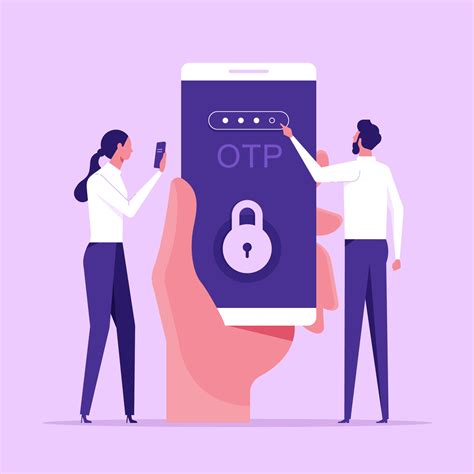One-Time Password (OTP): The Ultimate Guide to Enhanced Security
Introduction
In today's digital age, protecting our online accounts and personal information is paramount. One of the most effective ways to safeguard your data is by using One-Time Passwords (OTPs). This article delves into the world of OTPs, exploring their benefits, best practices, and implementation for enhanced security.
What is an OTP?
An OTP is a unique, temporary password that is generated and used only once. It is typically sent via SMS, email, or a dedicated app as a second layer of authentication after you have entered your regular password.
Benefits of Using OTPs
OTPs offer several key benefits that enhance security:

-
Prevents Account Takeovers: OTPs reduce the risk of account takeovers as they prevent unauthorized access even if a password is compromised.
-
Protects Against Phishing Attacks: OTPs help combat phishing attacks as attackers cannot access your account without the one-time password.
-
Enhances Fraud Prevention: OTPs can be used for financial transactions or online payments to verify identity and prevent unauthorized access.
Types of OTPs
There are different types of OTPs depending on the generation method:
:%20The%20Ultimate%20Guide%20to%20Enhanced%20Security)
-
SMS-Based OTPs: Generated and sent via SMS to a registered mobile phone number.
-
Email-Based OTPs: Generated and sent via email to a registered email address.
-
App-Based OTPs: Generated and stored within a dedicated mobile app.
-
Hardware Token-Based OTPs: Generated and displayed on a physical hardware token.
Best Practices for OTP Implementation
To maximize the effectiveness of OTPs, consider the following best practices:

-
Use Strong Passwords: Combine strong passwords with OTPs to create an even more robust defense.
-
Enable Multi-Factor Authentication (MFA): Incorporate OTPs into MFA systems to provide multiple layers of protection.
-
Stay Vigilant: Stay alert for suspicious emails or text messages requesting OTPs and report any unauthorized activity.
-
Use Trusted Apps: Choose OTP apps from reputable sources to ensure their reliability.
-
Consider Hardware Tokens: Hardware tokens can provide an additional level of security for sensitive accounts.
Common Mistakes to Avoid
To prevent compromising OTP security, avoid these common mistakes:
-
Sharing OTPs: Never share your OTP with anyone, including those claiming to be from official organizations.
-
Storing OTPs in Plain Text: Avoid writing down or storing OTPs in unsecured locations as they can be easily accessed by unauthorized individuals.
-
Using OTPs Outside Their Intended Purpose: OTPs are only meant for one-time use; never reuse them.
-
Ignoring Security Updates: Keep your OTP apps and software up-to-date to prevent vulnerabilities.
-
Using Weak Devices: Avoid generating or using OTPs on unsecured or compromised devices.
Step-by-Step Approach to Implementing OTPs
Follow these steps to implement OTPs for your online accounts:
-
Enable MFA: Visit the security settings of your online accounts and enable Multi-Factor Authentication.
-
Choose an OTP Type: Select the OTP type that best suits your needs and preferences.
-
Set Up the OTP System: Follow the instructions provided by the chosen OTP method.
-
Verify Your Identity: Enter your OTP to verify your identity when prompted.
-
Stay Vigilant: Monitor your accounts for unauthorized activity and report any suspicious behavior.
Stories and Lessons Learned
Story 1:
Sarah received an email from her bank requesting an OTP for a transaction she did not recognize. She ignored the request and later discovered that her account had been compromised. The OTP would have protected her by preventing unauthorized access.

Lesson: Always stay vigilant and never share OTPs with anyone, even if they appear to come from legitimate sources.
Story 2:
John enabled MFA for his social media account but used a weak password. Hackers were able to guess his password and gain access to his account. The OTP would have prevented this as it would have required an additional step of verification.
Lesson: Combine OTPs with strong passwords and enable MFA for maximum security.
Story 3:
Mary stored her OTPs in a text file on her desktop. When her computer was infected with malware, her OTPs were stolen and used to access her online accounts.
Lesson: Store OTPs securely and never write them down in plain text.
Tips and Tricks
-
Use different OTPs for different accounts: This prevents unauthorized access to multiple accounts if one OTP is compromised.
-
Set up OTPs for sensitive transactions: Use OTPs for financial transactions, online payments, and other sensitive activities.
-
Disable OTPs if not in use: If you are not actively using an OTP-protected account, disable OTPs to prevent potential misuse.
-
Consider using dedicated devices for OTPs: For increased security, dedicate a specific device for generating and storing OTPs.
Conclusion
OTPs are an essential tool for enhancing online security. By understanding the different types, benefits, and best practices, you can effectively protect your accounts and personal information from unauthorized access. Remember to implement OTPs with care, stay vigilant, and report any suspicious activity to safeguard your digital footprint.
